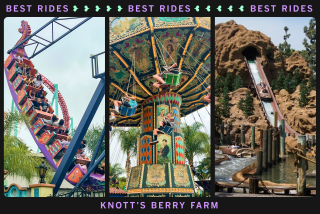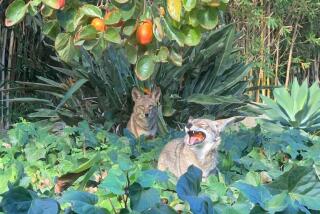FOCUS : Bellehurst - Northern Buena Park
- Share via
Tony the Pony and “the zebra from Buena Park” (an onager horse) may not be the most prominent residents of northern Buena Park, but they are its eldest: They are the fossil remains, discovered within what is now the Ralph B. Clark Regional Park, of creatures that became extinct 250,000 years ago.
“Horses started out in North America” and were not just introduced with the Spaniards’ discovery of the New World, says Steve Conkling, the Orange County Environmental Management Agency’s first paleontologist in residence at the park’s interpretive center. “Fossils have been excavated for the plain (standard) vanilla horse and onager horse,” the latter of which most closely resembles the present-day zebra. “Like a zebra from Buena Park,” he adds.
Those types of horses “went extinct before the Indians,” he says. “Spaniards reintroduced the species.”
The interpretive center--established in 1988 and open from 9 a.m. to 3 p.m. Tuesdays through Sundays--and the running excavations are just two of the drawing points for the Bellehurst section. Statistics show that adults ages 25 to 65 predominate the area and enjoy the open land offered by the park, which borders the Los Coyotes Country Club. But their children, particularly third-graders, will remember the interpretive center’s displays of prehistoric mammal skeletons and their own attempts at excavation.
Last year, 45,000 children toured the center, Conkling says.
“Everybody likes dinosaurs,” he says, but the tours at the center are “interactive, with a lot of demonstrations and hands-on material” and the search for fossils.
The number of students at the local elementary schools in Bellehurst explains the number of third-grade visitors to the center. At Gordon H. Beatty Elementary School on Country Club Drive, the 800 students are from as far south as Artesia Boulevard and as far west as Beach Boulevard. The Charles G. Emery School on Somerset Drive has 563 students, not solely from the Bellehurst area but also from other areas of Buena Park.
The center’s own excavations “are ongoing but not necessarily daily,” he says. “Everything else is done by volunteers; they do the excavations and deal with the public. The excavation will be closed (some days) because no one showed up that day.”
Excavation “doesn’t take a degree, just an interest,” Conkling says.
“Tony the Pony” is a fossil horse about 85% complete. Its excavation has not been finished because of its proximity to a toxic-waste dump. The McCall site is next to the park on the east side.
“There are probably fossils underneath,” Conkling says. “A fossil is one more element in the rock. These animals were living there when the rocks were being made.”
More than 30 years ago, visitors to the area would have seen fireplaces, stone slabs and piles of lumber standing in undeveloped fields. According to Buena Park building and safety manager Bob Gallagher, home tracts had been started there, “but the company went belly up.”
The lumber was stolen and the homes remained unfinished. Individual homes that now exist were built, starting in the 1960s.
Homes in Bellehurst range from mansions great and small to condominiums and apartments. Apartments appear on and just off Malvern Avenue on the southern edge. There are five condominium complexes within the area.
Highland Greens is probably the oldest of the condo complexes, built in 1964-66. Its 32.9 acres are bordered by Beach Boulevard to the west and Argyle Drive to the east. There are central greens between each pair of two-story, beige, stucco buildings, which contain 385 condominiums. Street names include Glengarry Green, Ginniss Green and Haseltine Green.
Smith Murphy Park is a grassy open space on Cameron Drive with children’s play equipment. It stretches out across the street from an unobtrusive apartment complex.
The homes and lot sizes seem to grow larger as they rise along the gentle incline of the Bellehurst area from Malvern Avenue north along Country Club Drive and continuing on the side streets that often end in cul-de-sacs. Homes are for the most part single-story mansions.
The Los Coyotes Hills, named after the coyotes that have roamed the area for more than 70,000 years, lend their name as well to the local country club. Los Coyotes Country Club was established in 1957 as a private country club with a golf course, tennis courts and a pool, according to the club’s general manager, Chuck Conway.
Information beyond this is, however, “confidential,” he says. Coyotes, more communicative, can still be heard on quiet spring evenings.
Population Total: (1989 est.) 6,710 1980-89 change: +4.6% Median Age: 38.5 Racial/ethnic mix:
White: (non-Latino) 79%
Latino: 11%
Black: 1%
Other: 9% By sex and age: In hundreds
MALES Median age: 37.3 years
FEMALES Median age: 39.5 years
Income Per capita: $22,783 Median household: $57,549 Average household: $63,595 Income Distribution:
Less than $25,000: 12%
$25,000-49,999: 29%
$50,000-74,999: 30%
$75,000-$99,999: 15%
$100,000 and more: 14%
More to Read
Sign up for The Wild
We’ll help you find the best places to hike, bike and run, as well as the perfect silent spots for meditation and yoga.
You may occasionally receive promotional content from the Los Angeles Times.






